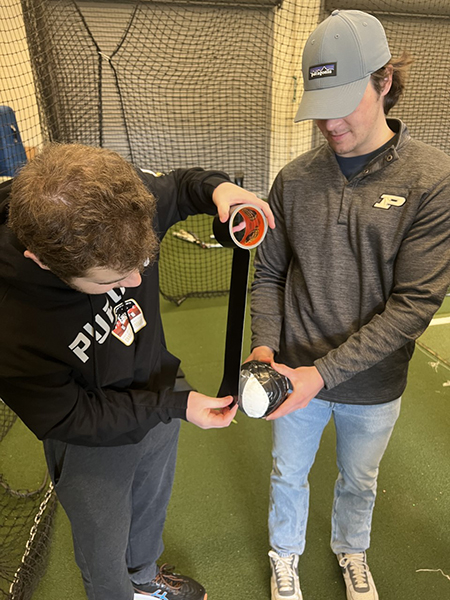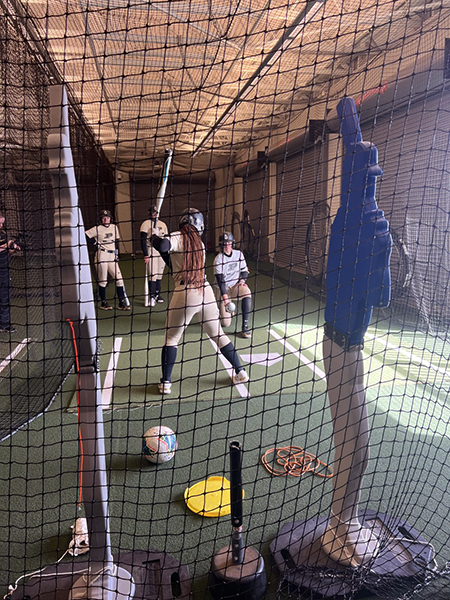EPICS project improves durability of baseball for vision impaired
It’s summer and the sights and sounds of America’s pastime can be seen and heard in countless fields. But what if you’re visually impaired and want to play ball?
That’s where groups like the National Beep Baseball Association (NBBA) come in. Their goal is to facilitate and provide an adaptive version of America’s favorite pastime for the blind, low-vision and legally blind.
Nearly 40 years ago that privilege wasn’t an option. But a specially designed ball that beeps gives players the ability to locate the ball and navigate the field to score runs. The ball uses counts with a speaker and sound circuit that beeps while in play.
One of the drawbacks of the ball is that it can’t withstand lots of hits. A Purdue EPICS team called BB8 wants to change that. During the past year, students worked with a beep baseball team in Indianapolis to redesign the ball the league uses and tested it with the Purdue softball team.

Jorge Martinez, outreach program manager for Purdue’s EPICS University Consortium, said the project was brought to EPICS a few years ago by a fan and volunteer from Indianapolis. Currently, there is only one approved source of beeping baseballs, and it is staffed by volunteers.
“Some of the ball components are dated,” Martinez said. “The spirit of the project is not only to design a more durable beeping baseball, but to develop a cost-effective manufacturing process with newer components that may help the league to expand operations, if they choose to do so, and to alleviate sourcing issues. The design and process would have to be shared and tested before is approved and implemented by the NBBA.”
A former EPICS student team made significant progress during the 2021-2022 academic year but could not deliver a ball due to complications with wireless charging, a feature they wanted to add. The 2022-2023 BB8 team focused on simplifying the design and validating durability, so they could deliver a viable product. The team included First-Year Engineering students Daniel Bouharb, Natalie Cooper, Armaan Kanchan, Alani Martinez, Farren Martinus and Lewis Turley, environmental geosciences student Madeline Baker and elementary education students Maggie Ross and Aubrianna Walker.
Although the team was unable to deliver the final product, they left the foundation for a new team to document the process and submit it to one of the local teams for consideration. If the team likes it, they could sponsor the new design and present it to the NBBA.
The BB8 students were aiming for a ball that could survive over 100 hits and contacted Purdue’s softball team to test their product.
Alani Martinez served as BB8’s project partner liaison. She said the collaboration began as the team brainstormed ways to see how many hits the ball could withstand while analyzing what previous teams had accomplished. She approached Amie Anthrop, then supervisor of softball operations at Purdue, about the project.
“Originally we were designing a 16-inch softball, but Amie informed me that the size was bigger than a regular 12-inch softball, so it wouldn’t fit into a pitching machine,” she said.
Anthrop suggested instead that members of the softball team do the testing.

Martinus, lead designer and head of the electrical group, said the goal was to create a new design.
“The current ball only lasts around seven hits and is no longer readily available due to the lack of production of its internal components,” he said. “We designed a softball that lasts over 100 hits, is more cost effective and still functions as the previously ball did. With our work and continuous innovations, we hope to preserve the league for many years to come.”
Martinus said the team made a series of changes to the design from previous semesters. They simplified the electrical set up by condensing the three printed circuit boards used in previous semesters into one.
“This simplified the manufacturing process, made the ball more cost effective and yielded less places for connection errors,” he said. “For the mechanical side of the project, we continued to create the manufacturing plan for the hemispherical mold design we are currently using.”
Bouharb was co-leader of the mechanical team. He said the mechanical team collaborated with the electrical team to ensure that any changes made with the electrical components were compensated for in the mechanical components.
“The main goal of most of the mechanical team’s work was to secure and protect the electrical components, so this was the most important part of our components,” Bouharb said. “However, we also worked to make sure the ball was easy to use, worked as expected and could be easily reproduced.”
The BB8 team had softball players hit the ball 100 times, rotating every five hits. The core of the ball was undamaged and showed no signs of deterioration after the 100 hits.
Bouharb participated in the BB8 project because he had previously worked with Miracle League, a volunteer organization that helps children with different physical and cognitive disabilities to play baseball.
“I felt that I was already connected to the project in a way,” he said. “This class will help me in my future classes because now I have the knowledge to lead a team, collaborate with peers and work on a project to complete a goal. I hadn't worked on a project in this way before, so it provided me with fresh ideas and experiences that will shape the way I work in the classroom and beyond.”
Martinus said the project provided a challenge.
“I designed the printed circuit boards, which was something that I have never done before,” he said. “Over the course of the semester, my understanding of electronics, specifically PCBs, drastically increased due to my hands-on experiences. I hope to apply this knowledge to the biomedical field in hopes of creating medical devices and/or wearable sensors to track vitals.”
The project is perfect for EPICS, Jorge Martinez said, as it allows students to service a community organization while also gaining new knowledge, such as circuit design and material selection.
“The students also learn to define who the stakeholders are and what is important to them,” he said. “They can then practice empathy by designing technology adapted to the partners’ needs and not merely based on what the students find attractive or exciting.”
One of the ideas to expand sourcing was to share the manufacturing instructions with a company that employs people with disabilities to help them get a steady income.
